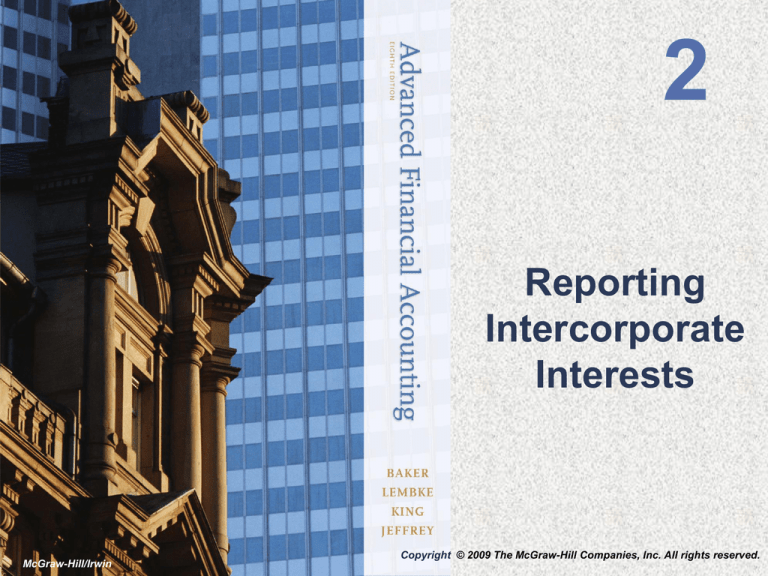
2
Reporting
Intercorporate
Interests
McGraw-Hill/Irwin
Copyright © 2009 The McGraw-Hill Companies, Inc. All rights reserved.
Accounting for Investments in Common
Stock
• The method used to account for
investments in common stock depends:
– On the level of influence or control that the
investor is able to exercise over the investee
– On choices made by the investor because of
options available
2-2
Financial Reporting Basis by Level of
Common Stock Ownership
2-3
Accounting for Investments in Common
Stock
• Consolidation involves combining for financial
reporting the individual assets, liabilities,
revenues, and expenses of two or more related
companies as if they were part of a single
company
– Consolidation normally is appropriate when one
company, referred to as the parent, controls another
company, referred to as a subsidiary
– A subsidiary that is not consolidated with the parent is
referred to as an unconsolidated subsidiary and is
shown as an investment on the parent’s balance
sheet
2-4
Accounting for Investments in Common
Stock
• The equity method is used when the investor
exercises significant influence over the operating
and financial policies of the investee and
consolidation is not appropriate
– May not be used in place of consolidation if
consolidation is appropriate
– Its primary use is in reporting nonsubsidiary
investments
• The cost method is used for reporting
investments in equity securities when both
consolidation and equity-method reporting are
inappropriate
2-5
The Cost Method
• Used when the investor lacks the ability
either to control or to exercise significant
influence over the investee
• Accounting Procedures
– The cost method is consistent with the
treatment normally accorded noncurrent
assets
2-6
The Cost Method
– At the time of purchase, the investor records
its investment in common stock at the total
cost incurred in making the purchase
– The investment continues to be carried at its
original cost until the time of sale
– Income from the investment is recognized as
dividends are declared by the investee
– Recognition of investment income before a
dividend declaration is inappropriate
2-7
The Cost Method - Illustration
ABC Company acquires 20 percent of XYZ Company’s common stock for
$100,000 at the beginning of the year but does not gain significant influence
over XYZ. During the year, XYZ has net income of $60,000 and pays
dividends of $20,000. ABC Company records the following entries:
Investment in XYZ Company Stock
Cash
Record purchase of XYZ Company stock.
Cash
Dividend Income
Record dividend income from XYZ Company:
$20,000 x .20
100,000
100,000
4,000
4,000
2-8
The Cost Method
• Declaration of dividends in excess of earnings
since acquisition
– Liquidating dividends - Dividends declared by the
investee in excess of its earnings since acquisition by
the investor from the investor’s viewpoint
– The investor’s share of these liquidating dividends is
treated as a return of capital, and the investment
account balance is reduced by that amount
– These dividends usually are not liquidating dividends
from the investee’s point of view
• Acquisition at interim date
– Does not create any major problems when the cost
method is used
– Potential difficulty - liquidating dividend determination
2-9
The Cost Method
• Changes in the number of shares held
– Changes resulting from stock dividends, stock splits,
or reverse splits receive no formal recognition in the
accounts of the investor
• Purchases of additional shares
– Recorded at cost similar to initial purchase
– New percentage ownership is calculated to determine
whether switch to the equity method is required
• Sales of Shares
– Accounted for in the same manner as the sale of any
other noncurrent asset
2-10
The Equity Method
• The equity method is intended to reflect
the investor’s changing equity or interest in
the investee
• The investment is recorded at the initial
purchase price and adjusted each period
for the investor’s share of the investee’s
profits or losses and the dividends
declared by the investee
2-11
The Equity Method
• APB Opinion No. 18 (as amended), requires
that the equity method be used for:
1. Corporate joint ventures
2. Companies in which the investor’s voting stock
interest gives the investor the “ability to exercise
significant influence over operating and financial
policies” of that company
• “Significant influence” criterion - 20 percent rule
– In the absence of evidence to the contrary, an
investor holding 20 percent or more of an investee’s
voting stock is presumed to have the ability to
exercise significant influence over the investee
2-12
The Equity Method
• Investor’s equity in the investee
– The investor records its investment at the
original cost
– This amount is adjusted periodically:
Reported by Investee
Net income
Effect on Investor’s Accounts
Record income from investment
Increase investment account
Net loss
Record loss from investment
Decrease investment account
Dividend declaration
Record asset (cash or receivable)
Decrease investment account
2-13
The Equity Method - Illustration
ABC Company acquires significant influence over XYZ
Company by purchasing 20 percent of the common
stock of the XYZ Company for $100,000, XYZ earns
income of $60,000 and pays dividends of $20,000.
• Recognition of income
Investment in XYZ Company Stock
Income from Investee
Record income from investment in XYZ Company:
$60,000 x .20
12,000
12,000
– This entry (equity accrual) is normally is made as an
adjusting entry at the end of the period
– If the investee reports a loss, the investor recognizes its
share of the loss and reduces the carrying amount of the
investment by that amount
2-14
The Equity Method - Illustration
• Recognition of dividends
Cash
4000
Investment in XYZ Company Stock
Record receipt of dividend from XYZ: $20,000 x .20
4000
• Carrying amount of the investment
Investment in XYZ Common Stock
Original cost
100,000
Equity accrual
Dividends
($60,000 x .20)
12,000 ($20,000 x .20)
Ending balance
108,000
4,000
2-15
The Equity Method
• Acquisition at Interim Date
– No income earned by the investee before the
date of acquisition may be accrued by the
investor
– Acquisition between balance sheet dates
• The amount of income earned by the investee
from the date of acquisition to the end of the fiscal
period may need to be estimated by the investor in
recording the equity accrual
2-16
The Equity Method
• Differential
– The difference between the cost of the investment to
the investor and the book value of the investor’s
proportionate share of the investee’s net assets
– The differential on the parent’s books relates only to
the parent’s share of any difference between an total
investee’s fair value and book value
– The differential in the case of an equity-method
investment is implicit in the investment account on the
parent’s books and is not recorded separately
2-17
The Equity Method
• Reasons for the differential
– Investee’s assets worth more than their book values
– Existence of unrecorded goodwill
• Ascertain the portion of the differential pertaining
to each asset of the investee, including goodwill
– The portion of the differential pertaining to limited-life
assets, including identifiable intangibles, must be
amortized over their remaining economic lives
– Any portion of the differential that represents goodwill
is not amortized or written off because of impairment
2-18
The Equity Method
• Amortizing the differential
– Reduce the income recognized by the
investor from the investee and the balance of
the investment account:
Income from Investee
Investment in Common Stock of Investee
XXX
XXX
2-19
Treatment of the Differential Illustrated
Ajax Corporation acquires 40 percent of the common stock of Barclay
Company on January 1, 20X1, for $200,000. Barclay has net assets on that
date with a book value of $400,000 and fair value of $465,000. Ajax’s share of
the book value of Barclay’s net assets at acquisition is $160,000 ($400,000 x
.40). A $40,000 differential is computed as follows:
Cost of investment to Ajax
Book value of Ajax’s share of Barclay’s net assets
Differential
$200,000
(160,000)
$40,000
The $65,000 excess consists of a $15,000 increase in the value of Barclay’s
land and a $50,000 increase in the value of equipment. Ajax’s 40 percent
share of the increase in the value of Barclay’s assets is as follows:
Land
Equipment
Total Increase
$15,000
50,000
$65,000
Ajax’s 40% Share
$6,000
20,000
$26,000
2-20
Treatment of the Differential Illustrated
$26,000 of the differential is assigned to land and equipment,
with the remaining $14,000 attributed to goodwill as follows:
2-21
Treatment of the Differential Illustrated
The equipment is amortized over its remaining life of five years. Land has an
unlimited economic life. Barclay declares dividends of $20,000 during 20X1
and at year-end reports net income of $80,000 for the year. Using the equity
method, Ajax records the following entries during 20x1:
Investment in Barclay Stock
Cash
Record purchase of Barclay stock.
Cash
200,000
200,000
8,000
8,000
Investment in Barclay Stock
Record dividend from Barclay: $20,000 x .40
Investment in Barclay Stock
Income from Investee
Record equity-method income: $80,000 x .40
Income from Investee
Investment in Barclay Stock
Amortize differential related to equipment.
32,000
32,000
4,000
4,000
2-22
The Equity Method
• Disposal of differential-related assets
– Upon disposal, the relevant portion of the differential
must be removed from the investment account on the
investor’s books
– The investor’s share of the investee’s gain or loss on
disposal of the asset must be adjusted to reflect the
fact that the investor paid more for its proportionate
share of that asset than did the investee
• Impairment of Investment Value
– Equity-method investments be written down if their
value is impaired
– Subsequent recoveries may not be recognized
2-23
The Equity Method
• Purchases of additional shares
– If the equity method was being used to
account for shares already held, the
acquisition involves adding the cost of the
new shares to the investment account and
applying the equity method from the date of
acquisition forward
– New and old investments in the same stock
are combined for financial reporting purposes
2-24
The Equity Method
• Sale of shares
– Treated the same as the sale of any noncurrent asset
– First, the investment account is adjusted to the date
of sale for the investor’s share of the investee’s
current earnings
– Then, a gain or loss is recognized for the difference
between the proceeds received and the carrying
amount of the shares sold
– If only part of the investment is sold, the investor must
decide whether to continue using the equity method
or to change to the cost method
2-25
The Cost and Equity Methods
Compared
2-26
The Fair Value Option
• FASB 159 permits but does not require
companies to make fair value measurements
– Option available only for investments that are not
required to be consolidated
– Rather than using the cost or equity method to report
nonsubsidiary investments in common stock,
investors may report those investments at fair value
– The investor remeasures the investment to its fair
value at the end of each period
– The change in value is then recognized in income for
the period
– Normally the investor recognizes dividend income in
the same manner as under the cost method
2-27
The Fair Value Option - Illustrated
Ajax Corporation purchases 40 percent of Barclay Company’s common stock
on January 1, 20X1, for $200,000. Barclay has net assets on that date with a
book value of $400,000 and fair value of $465,000. On March 1, 20X1, Ajax
receives a cash dividend of $1,500 from Barclay. On March 31, 20X1, Ajax
determines the fair value of its investment in Barclay to be $207,000. During
the first quarter of 20X1, Ajax records the following entries:
January 1, 20X1
Investment in Barclay Stock
Cash
Record purchase of Barclay Company stock.
March 1, 20X1
Cash
Dividend Income
Record dividend income from Barclay Company.
March 31, 20X1
Investment in Barclay Stock
Unrealized Gain on Increase in Value of Barclay Stock
Record increase in value of Barclay stock.
200,000
200,000
1,500
1,500
7,000
7,000
2-28
Interests Other than Investments in
Common Stock
•
Investments in partnerships
– FASB pronouncements generally relate to
corporations rather than partnerships
– Companies therefore have more flexibility
but less guidance in reporting their
investments
– Traditionally chosen methods:
1.
2.
3.
4.
Cost method
Equity method
Pro rata consolidation
Consolidation
2-29
Reporting Methods Illustrated
On January 1, 20X5, Albers Company invests $200,000 for a 40
percent share of initial capital of AB Partnership and a 40 percent
share of the profits and losses. For the year 20X5, Albers reports
the following, excluding its investment in AB Partnership:
Revenues, 20X5
Expenses, 20X5
Assets, 12/31/20X5 (excluding investment in AB)
Liabilities, 12/31/20X5
$700,000
400,000
1,000,000
300,000
Additional information:
The AB Partnership reports $80,000 of revenues and $50,000 of
expenses. No amounts are distributed to or withdrawn by the
partners.
2-30
Reporting Alternatives for Equity
Interests in Partnerships
2-31
Reporting Alternatives for Equity
Interests in Partnerships
2-32
Interests Other than Investments in
Common Stock
• Standards for reporting partnership interests
– The cost method provides little information relating to
the partnership investment and, thus, is generally not
appropriate
– The equity method can hide partnership debt and
disguise the type of income earned by the partnership
– Both pro rata consolidation, especially for
unincorporated joint ventures, and full consolidation
have received significant support
– The fair value approach also might be taken
2-33
Interests Other than Investments in
Common Stock
• Standards for reporting partnership
interests
– Extremely difficult to establish standards
• FASB Interpretation No. 46
– Its provisions do apply in to partnership
interests in some instances
– The interpretation establishes standards for
when certain types of entities should be
consolidated by a particular investor
2-34
Interests Other than Investments in
Common Stock
• Nonequity interests in other entities
– Because of the diversity of the types of arrangements
found in practice, no standards exist to cover all
potential situations
– Some standards may have an indirect bearing on
aspects of nonownership interests, such as the
FASB’s requirement to report guarantees at fair value
– The FASB’s pronouncements on VIEs and certain
types of special-purpose entities are applicable in
some cases to nonownership interests
2-35
Additional Considerations Relating to
the Equity Method
• Determination of significant influence
– 20 percent rule
– APB 18 - Factors that could constitute other evidence
of the ability to exercise significant influence:
1.
2.
3.
4.
5.
6.
Representation on board of directors.
Participation in policy making.
Material intercompany transactions.
Interchange of managerial personnel.
Technological dependency.
Size of investment in relation to concentration of other shareholdings.
2-36
Additional Considerations Relating to
the Equity Method
• FASB Interpretation No. 35 - Examples of
evidence that an investor is unable to exercise
significant influence over an investee:
F
F
F
F
Legal or regulatory challenges to the investor’s influence by the investee
Agreement by the investor to give up important shareholder rights
Concentration of majority ownership among a small group of owners who
disregard the investor’s views
Unsuccessful attempts by the investor to obtain information from the
investee or representation on the investee’s board of directors
2-37
Additional Considerations Relating to
the Equity Method
• Unrealized intercompany profits
– The equity method as applied under APB 18 often is
referred to as a one-line consolidation
– The view currently taken in consolidation is that
intercompany sales do not result in the realization of
income until the intercompany profit is confirmed
– Fully adjusted equity method
• Adjusting for unrealized intercompany profits
– Any intercompany profit remaining unrealized at the
end of the period must be deducted from the amount
of income that otherwise would be reported
2-38
Additional Considerations Relating to
the Equity Method
Additional Requirements of APB 18
1. The investor’s share of the investee’s extraordinary items and prior-period
adjustments should be reported as such by the investor, if material.
2. If an investor’s share of investee losses exceeds the carrying amount of the
investment, the equity method should be discontinued once the investment
has been reduced to zero.
3. Preferred dividends of the investee should be deducted from the investee’s net
income if declared or, whether declared or not, if the preferred stock is cumulative,
before the investor computes its share of investee earnings.
Required financial statement disclosures.
1. The name and percentage ownership of each investee.
2. The investor’s accounting policies with respect to its investments in common
stock, including the reasons for any departures from the 20 percent criterion.
3. The amount and accounting treatment of any differential.
4. The aggregate market value of each identified nonsubsidiary investment where
a quoted market price is available.
5. Either separate statements for or summarized information as to assets, liabilities,
and results of operations of corporate joint ventures of the investor, if material in
the aggregate.
2-39
Additional Considerations Relating to
the Equity Method
• Investor’s share of other comprehensive income
– The investor’s comprehensive income should include
its proportionate share of each of the amounts
reported as “Other Comprehensive Income” by the
investee
• Tax allocation procedures
– When an investor and an investee file a consolidated
tax return, intercompany dividends and income
accruals are eliminated in determining taxable income
– Consolidated tax returns may be filed when an
investor owns at least 80 percent of a subsidiary’s
stock and elects to file a consolidated return
2-40
Additional Considerations Relating to
the Equity Method
– If an investor and an investee file separate tax
returns, the investor is taxed on the dividends
received from the investee rather than on the
amount of investment income reported
2-41
Additional Considerations Relating to
the Equity Method
• Accounting for investments in subsidiaries
– Because investments in consolidated subsidiaries are
eliminated when consolidated statements are
prepared, the consolidated statements are not
affected by the procedures used to account for the
investments on the parent’s books
– Companies follow three different approaches in
accounting for their consolidated subsidiaries:
• Fully adjusted equity method
• Modified version of the equity method
• Cost method
2-42








